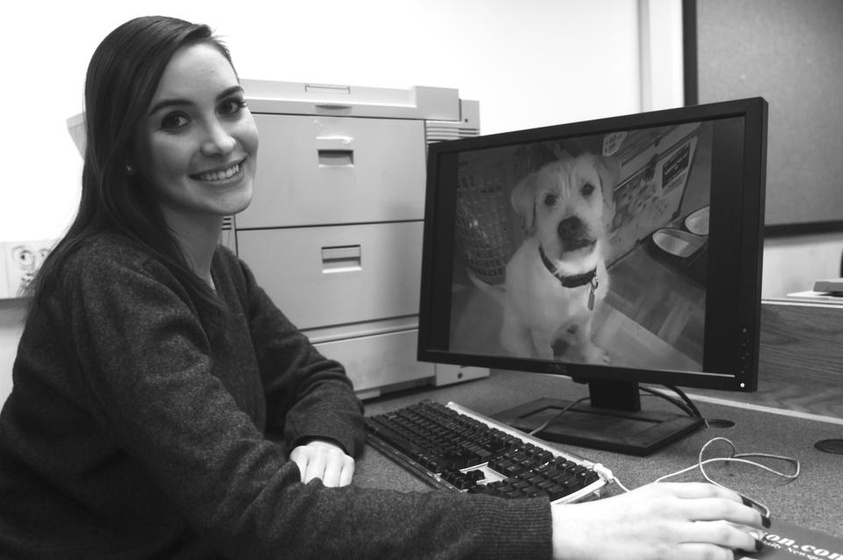I should have been studying for my final, but after flipping through what must have been hundreds of different pictures on petfinder.com, one in particular caught my eye. Otto was adorable, scruffy, and had the most beautiful eyes. I called my mom immediately.
We certainly hadn’t planned to get a dog so soon, but within minutes I was on the phone with the shelter manager, learning all I could about Otto’s age, temperament, and overall health. Although I told the shelter that we wouldn’t be making any decisions immediately, they put a sign on his cage that said, “I’m going to my new home!” Hearing about the sign did the requisite tugging of heartstrings, and my mom and I felt committed. My dad, however, was harder to convince. After all, what could we really know about a dog from one picture of him? Our last dog, a yellow lab, had lived as an adored member of our family for 15 years, and his were big paw prints for any new dog to fill.
The world of animal shelters can be cruel and unfair. Animals are discriminated against based on their color (black cats are the least likely to be adopted), breed (pit bulls have an undeserved bad reputation) and age (few people want a dog in his golden years). In the South, where fewer people spay and neuter their pets, animal overpopulation is rampant, and shelters don’t have enough space or resources for the number of unwanted animals. Every day, people pay breeders for pedigree puppies, while in overcrowded shelters, thousands of healthy puppies are euthanized each year due to lack of space.
Across the country, there are volunteers willing to devote their time, energy, and money to find homes for as many adoptable pets as they can. They drive animals from overcrowded Southern shelters to better funded ones up north, foster them to make them more personable, and even fight in court to protect their rights. But at the high-kill North Carolina shelter where Otto was located, his chances of getting euthanized were too high for my mom and me to stomach. So while I egged her on, my mom began contacting every animal rescue organization she could find in North Carolina.
Her e-mails were answered by a rescue group which pulled Otto from the shelter and took him to a veterinarian. The rescue organization contacted my mom and told her that without her intervention on Otto’s behalf, and her perseverance in contacting possible rescues, he would have simply faded away at the shelter. But they also gave us bad news: Otto had heartworm, a mosquito-borne disease, sadly common among shelter dogs in the South, in which worms literally infest the dog’s heart. Prevention is easy, it requires nothing more than Heartgard medication, but the shelter was so severely under-funded, it couldn’t afford this basic medicine.
The heartworm news put a wrinkle in our adoption plans, since even after treatment, there would be a chance that the worms permanently damaged Otto’s heart. After the amount of time it took for my mom to recover from my last dog’s death, she wasn’t sure she could handle another dog with health problems.
But even if we couldn’t adopt him, we felt bound to Otto’s fate. My mom followed up with Otto’s foster, who told her that a wonderful dog rescue in Rochester, N.Y. had claimed him—they were paying for his transportation and heartworm treatment—so he was out of her hands now. Rather than let the trail grow cold, my mom immediately got in touch with the Rochester rescue, who thanked us for taking notice of Otto and engineering to have him saved from the shelter.
That’s when my mom realized she had the chance to make a difference. We both signed up to volunteer at our local animal shelter. My mom sent a check to the Rochester rescue to pay for Otto’s treatment, and a package to the shelter in North Carolina filled with enough medication to protect 75 dogs against heartworm and other illnesses.
A few days ago we received a letter in the mail, thanking us for our donation paying for Otto’s medical expenses. “He is eating tons, playing tug of rope, and grabbing shoes whenever possible. He is being a dog!” the woman wrote. “We promise to only place him with a family who will care for him as he should be cared for.” But the end of her letter was perhaps the most rewarding: “Enjoy the holidays and know you helped change his life.”
After weeks of anxiety, Otto has found his happy ending, and now other dogs at the North Carolina shelter will be spared the ordeal of heartworm. I doubt my family will ever see Otto, and once he gets adopted, we’ll never hear about him again. But something about this dog’s face, picked out from among hundreds, compelled us to help and prevented us from feeling apathetic about his fate. By taking a modicum of interest in his life, we helped get him out of a high-kill shelter and into a rescue, and from a steady decline to a healthy future. It began a ripple effect that will hopefully improve the lives of other unwanted, abandoned, and neglected animals. If that’s not a holiday miracle, I don’t know what is.
Kate A. Borowitz ’11 is an English concentrator in Adams House. She is advocating for a canine edition of Scoped.


